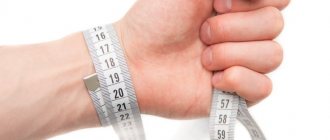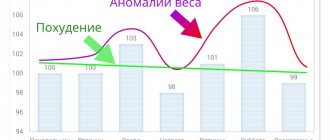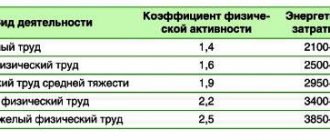Many people strive to change their weight. However, before taking specific actions to improve weight, you should find out how many calories a certain person requires for normal existence.
Currently, various methods are used that make it possible to determine the number of calories. Many experts recommend using several methods to obtain the most accurate information. After all, the results of using different methods can vary greatly.
Basic metabolism
The basal metabolic rate is a concept used in dietetics. This is the number of calories the body requires to maintain optimal functioning at rest. For example, the energy used to maintain blood circulation during a person’s sleep is taken into account. When identifying the optimal amount of calories, you should immediately assess your basal metabolism. Its size depends on many different factors:
- Floor
. According to statistics, women have less muscle mass and more fat deposits. Because of this, their basal metabolic rates are lower. - Weight
. Basal metabolic rates are higher in people who are overweight. - Genetic features
. Some people may have faster metabolic processes than others. Therefore, this factor cannot be changed. - Volume of body fat
. A large number of fat deposits can reduce the intensity of metabolic processes. - Body temperature
. A slight increase in temperature can cause metabolic processes to significantly accelerate. - Total body surface area
. Tall people have the highest basal metabolic rate. With a similar diet, tall people will gain weight much more slowly than short people. - Diet
. Using a diet can lead to a slowdown in metabolic processes by about 20 percent. We are talking about both fasting and low-calorie diets. - Hormonal background
. When calculating your basal metabolic rate, much attention should be paid to the hormone thyroxine, which is secreted by the thyroid gland. An increase in its quantity leads to an increase in basal metabolic rates.
In addition to the above factors, metabolic processes also depend on a person’s age. For example, after reaching age 20, they begin to gradually slow down, by about 2 percent each decade. Physical activity as well as ambient temperature must be taken into account.
Weight loss control in tables
In the measurement table, you record every week your weight, chest, waist, abdomen, hips, arms (shoulder), legs (thigh) and see what is happening to your body. If you follow the consultant's recommendations and complete the program without violations, then the measurement values will change negatively. It's clear. But I want to draw your attention to the following - the ratio of weight and volume indicators.
When a person begins the Herbalife weight loss program, he completely changes his diet and lifestyle. A balanced breakfast and proper dinner , 5-6 meals a day from healthy foods, daily consumption of water, physical activity - all this gives quick results at the first stage. There is a uniform decrease in indicators. In the future, the change in indicators may look different - the weight goes off more slowly, and the volume decreases faster, and vice versa. And that's okay. Our body is smart, it knows what it is doing. There is a very good article on this topic, read: Why weight loss slowly.
Control of body weight and volume
The basis of the Herbalife nutrition program is high protein foods. Protein is a building material. Protein “feeds” our muscles, causing lean body mass to increase in weight. At the same time, body fat mass decreases in weight, and we can see this in measurements.
For example, your weight a week ago was 94 kg , in a week muscle mass increased by 500 grams , and body fat mass decreased by 1 kg , what difference will the scales show?
94.00 + 0.5 – 1.00 = 93.5 kg
Our muscles have “gained weight” by 500 grams, and this is the formation of a beautiful figure, which is what we actually strive for! And the fat “lost” by 1 kg.
So how much weight did we lose in a week ? For 500 gr. or 1 kg? The correct answer is 1 kg!!!
And this 1 kg is reflected in body volume indicators. Look at the measurement table and make a correct assessment of your results.
And don’t forget that we gain weight slowly and we also need to get rid of it slowly so that the body has time to rebuild without stress and complications.
Today I have a long preface before presenting you with Irina Mikhailova’s report. The thing is that her post touches on the topic of weight loss control and analysis of results. Read her next report!
Methods for determining daily calorie needs
The easiest way to determine the optimal daily number of calories for one person is to study the research of physiologists Kaci and McArdle. They believe that every day a man needs 2,700 calories, while for women 2,100 calories are enough. However, these data can hardly be called accurate, since they do not take into account a person’s weight, as well as his daily activity. For example, weightlifters require at least 6,000 calories daily when training. There is another way to determine the optimal amount of calories. To use it, you will need to know the exact weight of a person.
- Burning fat reserves is only possible when up to 29 calories per kilogram of weight are consumed per day.
- Maintaining a certain body weight requires consuming up to 35 calories per kilogram of weight per day.
- If you need to gain weight, you should consume up to 40 calories per kilogram of weight per day.
The accuracy of the results of this method is also not ideal. After all, the calculations do not take into account a person’s physical activity, his height and degree of obesity. This will make it extremely difficult to achieve significant weight reduction for most people using this method.
Application of the Harrison-Benedict formula
This method was created in 1919. It got its name from the names of the scientists who invented it. The formula was subsequently adjusted in 1984, since over time the lifestyle of the population has changed significantly. Therefore, the following option is currently accepted:
- Determination of metabolic level in women - 447.593 + (9.247 x kg weight) + (3.098 x cm height) - (4.330 x age)
- Determination of metabolic level in men - 88.362 + (13.397 x kg weight) + (4.799 x cm height) - (5.677 x age)
However, identifying metabolic levels for individuals is not enough. It is also important to understand how many calories you need to consume to change your body weight. Their number depends on physical activity. If there is no or low physical activity, enough calories are equal to the metabolic rate multiplied by 1.2. For low activity the coefficient is 1.375, for moderate activity it is 1.55, and for high activity it is 1.725. Low physical activity means up to three workouts weekly, moderate physical activity means three to five workouts, and high physical activity means six or more.
For people who do a lot of physical exercise and train more than 8 times a week, calories can be calculated using the formula - metabolic rate multiplied by 1.9.
Like other methods, this formula also has its disadvantages:
- The genetic and physiological characteristics of the organism are not taken into account. After all, the speed of metabolic processes can vary greatly among different people.
- The calorie-burning effects of different exercises should be considered. For example, plyometric exercises are more effective than classical exercises.
- The type of diet affects how quickly you burn calories. With a protein diet, protein is burned more slowly than carbohydrates and fats.
Although the Harrison-Benedict formula is not ideal, it is quite capable of becoming a starting point on the road to changing body weight. When using this formula, it is recommended to adjust the calculations weekly, since due to exercise and diet, body weight will gradually decrease. To check the accuracy of the calculations, you need to calculate your body mass index at least once every two weeks.
Detection of body mass index
The optimal weight of a person can be easily calculated using a simple formula - Height (in cm) minus 110. That is, for a person 170 cm tall, the ideal weight will be 60 kg. However, this formula does not use information such as body fat size, muscle size, or lifestyle. Because of this, body mass index is easier to determine using the Adolph Ketel formula. Total body weight (in kg) divided by height (in meters) squared. Depending on the index, you may need to take the following actions:
- Index 18.5-24.9. This index is the norm. Therefore, you just need to consume enough calories and keep yourself in good shape.
- The index is less than 18.5. Anorexia may develop. Requires weight gain.
- The index is more than 25. We are talking about excess weight, and possibly obesity. Diet adjustments and regular physical activity are required.
The consequences of deviations from the optimal body mass index can be quite serious. A low mass index indicates that the body does not receive the required amount of nutrients. Because of this, teeth are destroyed, hair falls out and nails become brittle. Bones become more fragile, and anemia may develop. In women, reproductive functions may be impaired, which will lead to the inability to conceive a child.
If the index is less than 18, you should monitor your diet very carefully. For example, you should check that your body is getting the required amount of essential nutrients. People who are predisposed to thinness, without pathological changes, should not be alarmed by such index indicators.
A high index exceeding 25 can lead to the development of heart disease, pathological changes in blood vessels and the appearance of edema. It is recommended to change your diet and reduce your daily calorie intake. You should also start doing physical exercise.
A mass index above 40 directly indicates obesity. This indicates that you need to take the help of a nutritionist. You should not try to choose your own exercise course and diet.
The optimal index corresponds to the range 19-25. Statistically, very few people get results like this after calculating their body mass index. This also means simply keeping your body in optimal condition through regular exercise and a healthy diet.
Why take measurements?
When losing weight with the help of various means that cleanse the body, the weight goes away due to the removal of excess water, but the volumes practically do not change. Conversely, active physical activity reduces volume, but weight can remain the same due to the build-up of muscle, which weighs more than fat tissue.
In such situations, it seems that all the measures taken to lose weight are ineffective, since they do not have a tangible effect. By measuring volumes in parallel with weighing and entering the resulting figures into a special table, you can clearly see and evaluate your achievements, even if visually it seems that there is no progress .
How often to take measurements
Dry mathematical calculations will illustrate the process of losing weight much better than a visual examination of the figure or someone else’s opinion from the outside. It is recommended to record parameters no more often than once every two weeks, otherwise there is a risk of not seeing the changes that have occurred in the body and losing the proper psychological attitude. The difference between the numbers obtained from measurements taken at the correct interval will invariably increase and motivate you to continue all activities aimed at achieving an ideal shape.
When to take measurements
It is best to measure parameters in the morning, after you have already used the toilet, but before starting to eat, then there will be nothing unnecessary in the body that can lead to data errors. You should not measure yourself in the evening, because food and water taken during the day will inevitably affect the accuracy of the numbers. Even under conditions of a strict diet, swelling may appear in the evening, resulting from the stress suffered during the day.
What you will need to take measurements
The list of what you need is quite short and simple; in order to take quality body measurements when losing weight, you need to prepare:
- Scales;
- A mirror, preferably reflecting a full-length figure;
- Tailor's meter, soft but not stretchy;
- Table for entering the received data.
Scales
Mirror
Tailor's meter
Notebook
What to measure
Ideally, to obtain accurate information about changes in volumes, measurements are carried out on all possible parameters:
- Neck;
- Shoulder girdle;
- Bust volume;
- Volume under the bust;
- Waist, at the narrowest point;
- Waist in the navel area;
- Waist at its widest point;
- The pelvis is in the most protruding part;
- Hips under buttocks;
- One thigh of both legs;
- The thighs of both legs are above the knee;
- Shins of both legs;
- Ankles of both legs;
- Wrists of both hands;
- Forearms of both hands;
- Shoulders of both arms.
Be sure to read: What is ozone therapy and what are the results when losing weight?
In fact, due to the lack of time, everyone independently chooses which most problematic areas should be measured regularly, because it often happens that a set of measures aimed at losing weight is designed to reduce volume and tighten specific areas, such as the waist and buttocks, while others parts do not need correction.
Actions to reduce high body mass index
After doing the calculations and discovering an increased body mass index, many people immediately begin creating workout schedules and choosing the most effective diets. However, such measures should be used with caution. Large loads on the body during obesity are dangerous for people, for example, for their cardiac system. Therefore, you should first consult a nutritionist. The doctor will tell you what to eat and what exercises to do so that it does not cause harm to the body. Special treatments, such as diet pills or liposuction, cannot greatly affect your body mass index. When the course of using these funds ends, the weight will quickly return to its previous level. Sometimes body weight even increases. To lose weight, you first need to determine the optimal daily amount of calories. Regular exercise will also be required. Sometimes even regular walking is enough.
Fasting is not a safe way to reduce your body mass index. A sharp decrease in calories will only lead to damage to various internal organs. The minimum daily amount of calories is 1200. For some people, this is the recommended number of calories. However, only doctors can give such recommendations.
You can achieve weight loss not only by using the calorie calculation formula. He must also change his lifestyle. Diet and exercise alone will not be enough. A normal lifestyle involves drinking eight glasses of water daily. If high calorie content is important for breakfast, then for dinner it is recommended to eat something with a small amount of calories. You can achieve effective weight loss without harming your health with the help of experienced specialists. Professional nutritionists can easily select a suitable weight loss program for any person.
How to take measurements correctly
To obtain correct measurement data when losing weight, you should adhere to a number of rules:
- The process should take place in front of a mirror, it will allow you to see whether the tailor's meter is positioned correctly and will allow you to relax your muscles;
- It is recommended to measure one area more than once to avoid errors;
- Measurements are taken in the same area; if you are measuring the hip or shoulder, you should try to apply the meter to the same place each time, this will allow you to get more accurate numbers;
- The tailor's gauge should not fit tightly around the area being measured, but it should not be too loose.
The ideal option would be outside help; if someone else takes the measurements, the numbers will be as accurate as possible, so if there is an opportunity to involve someone close to you in the process, you should not neglect it.
In addition to the general rules for taking measurements when losing weight, there are separate recommendations for measuring each body parameter.
Neck
To measure your neck correctly, you need to straighten up, raise your head so that your chin points forward and is horizontal. There is no need to strain your muscles. The measuring tape is applied to the middle of the neck.
Shoulder girdle
Measuring the shoulder girdle means the circumference of both shoulders, the area of the shoulder blades and the chest. To obtain correct data, it is important to stand up straight, straighten your shoulders and relax your muscles.
Breast
Due to the fact that the muscles of the chest are located here, the indicators will differ greatly depending on the phase of inhalation and exhalation at which the measurements were taken. To make the readings more accurate, you should choose how the measurements will be taken. When taking measurements of chest volume, you should stand up straight, straighten your shoulders and relax your muscles.
Underbust circumference
To take measurements correctly, you need to relax, place the tailor's meter exactly under the chest, positioning it strictly horizontally, and move your arms away from the body. It is also worth deciding in advance in what phase the measurement will be taken, during inhalation or exhalation.
Waist in three places
The thinnest part of the waist is determined visually, and the widest part can coincide with the navel line. When taking measurements, you should not try to pull in your stomach or pull the meter too tightly; such self-deception will only lead to errors in measurements and will ultimately still be reflected in the calculations of weight loss dynamics. It should be remembered that the volume of the abdomen in women depends on the menstrual cycle; if the difference in indicators at some point becomes insufficient, there is no need to be alarmed.
Be sure to read: What methods should you use to fight cellulite?
Pelvis
Correct measurements of the pelvis, made independently, must be done in front of a mirror; it will help determine where the buttocks protrude as much as possible and correctly position the sewing centimeter. During the process, you should avoid tilting your body and keep your feet together. The buttock muscles should be relaxed.
Hips under buttocks
The circumference of the thigh under the buttocks should be measured with the feet together. To obtain the correct readings, bending over and straining your muscles should be avoided.
Mid thigh
To take correct measurements of the hip in this place, you need to spread your legs to the sides, standing with your full foot on the floor, you can raise your leg to an elevation, the bend angle at the knee should be about 40 degrees. It is recommended to place the centimeter in the widest place, it is located approximately 5 - 7 centimeters below the groin.
Thigh over knee
Measurements of this section of the leg are made in a standing position, the measuring tape is fixed strictly horizontally. The area directly above the kneecap is measured.
Shin
The girth of the lower leg is measured with both feet on the floor, or with the leg placed on a raised platform, but without lifting it onto the toe, in order to avoid straining the calf muscles. Measurements should be taken at the widest point of the calf. It should be remembered that the shins may change slightly in size due to swelling or due to muscle tension after physical activity.
Ankle
It is most convenient to take measurements of the lower leg in a sitting position. The leg should rest completely on the foot and be perpendicular to the floor. Measurements are taken at the narrowest point, which is 2-3 cm above the foot.
Wrist
To successfully take measurements, you should bend your arm at the elbow so that your wrist is at chest level and relax the muscles. The wrist is measured at its narrowest point, which is located directly above the bone.
Forearm
The forearm area is the part of the arm from the wrist to the elbow. To measure it correctly, you need to bend your arm at the elbow joint, thereby forming an angle of 90 degrees, and raise your forearm to chest level. The muscles should be relaxed; it is worth deciding in advance how to position the hand during measurement in order to remember the position and subsequently take measurements in the same state. The hand can be palm down or turned toward the chest, but it must form a straight line with the forearm.
Shoulder
The shoulder is the part of the arm located above the elbow. In order to correctly measure the circumference of the shoulder, you need to freely lower your arm or raise it perpendicular to the body, the main thing is to take regular measurements in the same position, otherwise the numbers will be inaccurate. The muscles should be relaxed during measurement.
Pedantic adherence to all the above rules and recommendations will allow you to obtain the most accurate measurement data, allowing you to track the dynamics of the weight loss process and evaluate the effectiveness of the chosen method of getting rid of extra pounds. You should try to avoid little tricks when measuring body volumes, such as tensing your muscles, pulling in your stomach or pulling too hard on the measuring tape, which are used to get higher measurements. This method of self-deception can only lead to a loss of motivation and all existing achievements.
Be sure to read: Hand massage technique for weight loss











